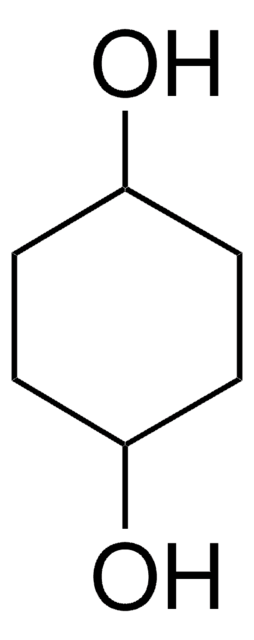O3303
1,8-Octanediol
98%
Synonym(s):
Octamethylene glycol
Sign Into View Organizational & Contract Pricing
All Photos(3)
About This Item
Linear Formula:
HO(CH2)8OH
CAS Number:
Molecular Weight:
146.23
Beilstein:
1633499
EC Number:
MDL number:
UNSPSC Code:
12352100
PubChem Substance ID:
NACRES:
NA.22
Recommended Products
Quality Level
Assay
98%
bp
172 °C/20 mmHg (lit.)
mp
57-61 °C (lit.)
SMILES string
OCCCCCCCCO
InChI
1S/C8H18O2/c9-7-5-3-1-2-4-6-8-10/h9-10H,1-8H2
InChI key
OEIJHBUUFURJLI-UHFFFAOYSA-N
Looking for similar products? Visit Product Comparison Guide
Related Categories
Application
1,8-Octanediol can undergo:
- Polycondensation with citric acid to form biodegradable poly(1,8-octanediol citrate)(POC) crosslinked bioelastomer which can be blended with various additives.
- Fischer esterification with dicarboxylic acids to form diol-based macromers.
Storage Class Code
11 - Combustible Solids
WGK
WGK 3
Flash Point(F)
248.0 °F - closed cup
Flash Point(C)
120 °C - closed cup
Personal Protective Equipment
dust mask type N95 (US), Eyeshields, Gloves
Choose from one of the most recent versions:
Already Own This Product?
Find documentation for the products that you have recently purchased in the Document Library.
Customers Also Viewed
Alexander M Tatara et al.
Biomacromolecules, 18(6), 1724-1735 (2017-05-11)
In this work, we describe the synthesis and characterization of variants of poly(diol fumarate) and poly(diol fumarate-co-succinate). Through a Fischer esterification, α,ω-diols and dicarboxylic acids were polymerized to form aliphatic polyester comacromers. Because of the carbon-carbon double bond of fumaric
Kai-Hee Huong et al.
International journal of biological macromolecules, 116, 217-223 (2018-05-04)
Long carbon chain alkanediols are used in the production of poly(3-hydroxybutyrate-co-4-hydroxybutyrate) [P(3HB-co-4HB)], however these substrates possess high toxicity towards bacterial cells. This study demonstrated the effective utilisation of a long carbon chain alkanediol, namely 1,8-octanediol, to enhance the yield and
Development of poly (1, 8-octanediol citrate)/chitosan blend films for tissue engineering applications.
Zeimaran E, et al.
Carbohydrate Polymers, 175, 618-627 (2017)
Yuanzheng Zhang et al.
PloS one, 12(8), e0182971-e0182971 (2017-08-12)
To explore the repairing effect of combination of adipose stem cells (ASCs) and composite scaffolds on CWR, the electrospun Poly 1, 8-octanediol-co-citric acid (POC)-poly-L-lactide acid (PLA) composite scaffolds were prepared, followed by in vitro and in vivo biocompatibility evaluation of
Yun He et al.
Acta biomaterialia, 93, 180-191 (2019-03-31)
The design and development of bioactive materials that are inherently conducive for osteointegration and bone regeneration with tunable mechanical properties and degradation remains a challenge. Herein, we report the development of a new class of citrate-based materials with glycerophosphate salts
Our team of scientists has experience in all areas of research including Life Science, Material Science, Chemical Synthesis, Chromatography, Analytical and many others.
Contact Technical Service







